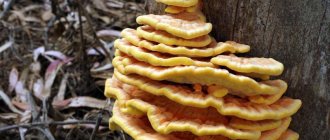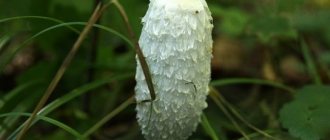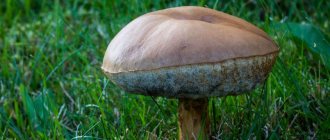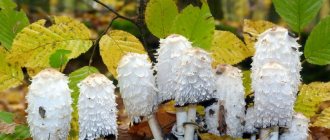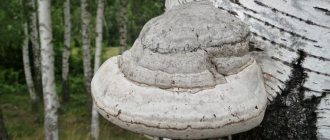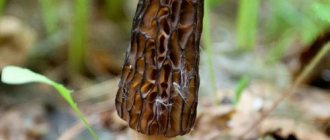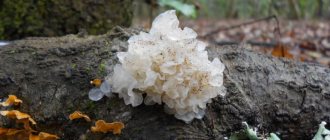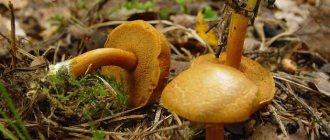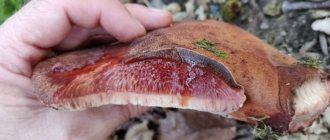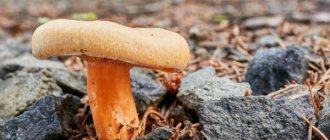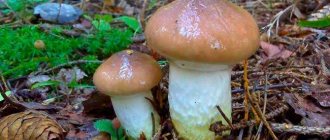Podorekhovik belongs to the genus Mlechniki, which is part of the Russula family. A special feature of the mushroom is the absence of strong bitterness, which is characteristic of laticifers. In addition to good taste, the fruit has healing properties, because it contains biologically active substances.
It is difficult to find this mushroom in the forests of our country - it is considered a rather rare species. In order not to miss the opportunity to put the boletus mushroom in your basket when the opportunity arises, you should carefully read its photo and detailed description and remember its characteristic features.
Mushroom Lactarius Volemus
A mushroom from the genus Milky, the Russula family, also known as the Red-Brown Mushroom, the Hazel, the Podorekhovik, the Euphorbia and the Milkweed.
This is, in fact, the only known species of milkweed mushrooms, whose milky juice not only does not taste bitter, but, on the contrary, tastes very pleasant, reminiscent of a kind of sweet milk, which makes this mushroom a favorite raw forest snack in the areas where it grows.
Appearance
The cap is up to 17 cm in diameter, at first it is convex in shape, then it gradually becomes prostrate, and in old age it can be pressed down in the center and even concave. The thin and sharp edges of the cap also change over time; initially it is tucked in, but over time it straightens out and can even rise.
The color of the cap varies from reddish or brownish-brown to rusty and light ocher, and its surface loses its velvety over time, dries out and may even crack.
The hymenophore is lamellar, the plates are frequent, adherent or slightly descending, often forked at the stem itself and having shortened plates. The plates are painted in cream shades. Spore powder is white.
The leg is up to 10 cm high and up to 3 cm thick, smooth and hard, often tapering downwards. It may have slight pubescence, and with age it becomes hollow. The color of the leg is slightly paler than the cap.
The pulp is very fleshy and dense, yellowish-white in color, turning brown when cut, with a pleasant sweetish taste and smell, which to most smellers seems similar to the smell of seafood or herring.
The milky juice is white, turns brown when exposed to air, is very abundant and has a pleasant sweetish taste.
Where and when does it grow
It grows from July to October in forests of various types, and can form mycorrhiza with oak and hazel. Loves moisture and mossy soils, bears fruit both in groups and individually. The mushroom is widespread in Belarus and the southwestern regions of Russia.
Culinary use
This mushroom is sometimes classified as conditionally edible, and it is officially believed that it must be soaked, like other milkweeds, but it can also be eaten raw, which is successfully done in rural areas where it is traditionally collected. Due to the pleasant taste of both the pulp and the milky juice, this mushroom simply does not have time to get from the forest to the frying pan. Some even compare the taste of its juice with the taste of condensed milk. However, it is strongly not recommended to eat it raw in large quantities, since it is a very heavy food for the stomach, which may well result in indigestion. It is also important to keep in mind that usually only young specimens of the fungus are eaten. In older people, the juice begins to taste bitter, and the characteristic “herring” smell takes on unpleasant notes. Hazelnut is also very good when fried, salted or pickled and is very rich in protein. This species is especially well suited for “raw pickling” or pickling, which is not suitable for every type of edible mushroom.
Scaly polypore
The scaly tinder fungus has, in particular, names such as hare and variegated. This parasitic mushroom is considered conditionally edible. Its fruit body has a whitish pulp of dense consistency, which is pleasant in smell and taste. At the same time, you can only eat young mushrooms, since old fruiting bodies have hard pulp.
In nature, the tinder fungus grows mainly on dead or living branches of trees and shrubs of fruit and broad-leaved species.
The growing period is May-September. The scaly polypore is a wound parasite, since its mycelium, penetrating into walnut wood, causes internal rot of a white-yellow color. As for the main characteristics of the mushroom, they are as follows:
- The white or cream cap of the parasitic fungus has a diameter of 5 to 50 cm and a thickness of 0.5-10 cm. In addition, the cap is covered with large pressed brown scales, which give it a variegated color, so this type of tinder fungus has another name - variegated . The edge of the mushroom cap is thin or bent inward.
- The mushroom stalk has a length of 1-4 cm and a diameter of 4-8 cm. The color of the stalk is cream or white, and almost black at the base. The tubular layer is light in color.
- The pied spores have an elongated oval shape and a size of 10-14x4-6 microns. The spores themselves are colorless, but the spore powder is white.
The scaly tinder fungus has, in particular, names such as hare and variegated
Since the fungus, which is a parasite, oppresses the walnut tree for 5-10 years, this fungus should be combated. In general, the set of measures to combat tinder fungus includes the following measures:
- Spraying trees with Bordeaux mixture during the deciduous period, and with a solution of copper sulfate 5% during the leafless period.
- Treatment of wounds on the trunk and branches by spraying with a 2% nitrophen solution.
- Cutting and burning of fruiting bodies, in which case the cut areas must be treated with copper sulfate 3%.
- Providing the tree with an optimal watering regime.
The scaly polypore is the most common parasitic fungus of the walnut tree, widespread not only in Ukraine, in particular in the Kyiv region, but also in other areas. The hare can be found not only on old, unkempt trees, but also in the gardens of holiday villages in large cities, for example, near Kiev, etc.
Cold salting of nutwood
- Rinse the fruiting bodies under running water.
- Separate the stems from the caps.
- Place the fruiting bodies in layers in a wooden, ceramic or enamel container, carefully sprinkling with salt at the rate of 50 g. salt per kilogram of mushrooms.
- Cover the last layer with gauze folded several times and press down with a lid of suitable diameter, for example, a large plate - so that its edges do not reach the edges of the container.
- Place a weight on top - a large jar filled with water will do.
- Place the container in a cool place for 1 month, while the lid and gauze should be washed at least once every two days.
In a month, an excellent salty snack from Podoreshnik will be ready!
Let's sum it up
You should not rely on the dogmas of traditional medicine alone. Before using sweetgrass as part of treatment or simply as part of a dish, you should analyze your condition and discuss this decision with a nutritionist, therapist or gastroenterologist.
In addition, the mushroom itself is quite difficult to get: it is rarely found in accessible parts of the forest. But even found old milkweed can disappoint with its specific taste.
| Leg | It grows up to 10 cm in length, in the middle it can be expanded, which makes the shape of the mushroom somewhat awkward. |
| Pulp | Faded, sometimes even gray. |
To soak or not?
The debate about whether or not it is necessary to soak the pine tree in water before use continues to this day. Many people do not like the specific “herring” smell of this mushroom, and they soak it in water for 2 days. However, it should be taken into account that soaking does not always help get rid of the smell. You can boil the mushrooms in salt water for 20 minutes - this usually helps get rid of the smell.
However, as already mentioned, many lovers eat Podashnik generally raw, without experiencing any discomfort, so this is more a matter of taste and habit.
After harvesting, fresh fruiting bodies should be stored in the refrigerator for no longer than 15 hours. After this period, they begin to deteriorate.
Varieties
The following varieties of milkweed are distinguished:
Such species are considered to be relatively tasty and edible. As for the other lesser-known varieties, they are bitter in taste, have smooth, non-cracked skin and do not have the characteristic milky juice.
Artificial cultivation
It is quite possible to grow the pine tree yourself on your own plot.
The mycelium of this mushroom can be purchased at a specialized store or obtained independently - take old specimens of mushrooms, carefully clean them of debris, but do not rinse them. Then grind them in a meat grinder, pour the resulting mixture with water and leave in a warm and dark place for two weeks. Then drain the workpiece through a colander - the cake can be thrown away, and the liquid will be the mycelium solution. Next you should proceed like this:
- As its name suggests, it should be grown under a walnut tree - the result will most likely be more impressive, although trees of other species can also be used.
- Carefully harrow the soil under the tree to a depth of 15 cm, acting as carefully as possible so as not to damage the roots.
- Plant the mycelium on the soil. If you made the solution yourself, pour it evenly over the planting area; if you use dry purchased mycelium, then it needs to be mixed with dry soil in a proportion of 0.5 kg. soil per 15 grams of mycelium, and plant evenly on the soil.
- Then cover the sowed surface with a mixture of humus and forest soil, in a 50/50 ratio, thoroughly pour it with water at the rate of 10 liters per square meter, and cover it on top with a mixture of sawdust and soil.
- The first harvest of mushrooms can be harvested in three months. Fruiting will continue in the same way as in natural conditions until the end of October. Just don’t forget to regularly water the “bed” with mushrooms.
Beneficial features
Podvoreshnik is rich in various useful substances. In particular, it contains:
- Microelements - cobalt, rubidium, iron, chromium, selenium, fluorine, phosphorus, magnesium, potassium, sodium and calcium.
- Acids - valine, tyrosine, threonine and lysine.
- Vitamins B9, B2, B6, PP, E.
- As well as ash, dietary fiber, sterol, cortisone, volemitol, ethanol extract, volemolide and sugar alcohol.
Due to the presence of beneficial properties, this mushroom has long been used in folk medicine as a remedy for:
- Anti-tumor
- Immunostimulation
- Improvement of the cardiovascular system.
- Strengthening joints and bones
- Stimulate skin regeneration
- Strengthening tooth enamel
- Increased hemoglobin levels
At the same time, Podoreshnik, like all mushrooms that are difficult for the stomach, is not recommended for young children (although they still collect it and eat it raw right in the forest), pregnant and lactating women and people suffering from hypertension, acute or chronic diseases of the gastrointestinal tract and kidneys.
Sparrow juice is considered a powerful antitumor agent, and a tincture of it is used for varicose veins, gout, otitis media, hemorrhoids, fever, bronchitis, runny nose, burns, allergic rashes and sore throat, both as an internal and external remedy.
How to make a healthy tincture from Sparrowgrass
- The fruiting bodies need to be dried by cutting them into thin plates, 1 cm thick, and hung on a thread in a shady and well-ventilated place.
- Grind dry mushrooms into powder in a blender and pour in olive oil at the rate of 0.5 liters of oil per 3 tbsp. spoons of powder.
- Then close the container with the tincture tightly and put it in a dark and warm place for 14 days.
- Store the finished composition in the refrigerator for 12 months.
Take the tincture as an internal preparation, you need 1 teaspoon 3 times a day; when used externally, the tincture is applied to the problem area of the body as needed.
Lactarius Hygrophoroides
Mushroom from the genus Milky, family Russula.
It is similar to our hero with a brownish-orange color and general outline, but is smaller - the cap grows up to 8 cm in diameter, and the leg grows up to 7 cm in length. Its milky sap does not turn brown in the air, and the external difference is easy to determine by the plates - they are also colored , but they are rarely spaced. However, this mushroom is also edible, although it does not possess the culinary merits of our hero.
Description
Podolshanik is a typical cap-shaped mushroom with a tubular hymenophore.
hat
The shape of the cap consistently changes with age from convex to almost flat. Its surface is uneven, dry in the absence of precipitation, and sticky in rainy weather. Color – brownish or reddish-gray. The size can reach 15 cm in diameter.
Leg
Reddish spots are often observed on the surface of the leg. There are never any remains of velum on the stem of the hemlock; the surface of the stem is smooth.
Pulp
The pulp of the undergrowth is yellowish, turning blue in the area of the cap when damaged. The stem is brownish and unchanged in color when cut. Does not have any pronounced taste or smell.
Orange Milky Lactarius Porninsis
Mushroom from the genus Milky, family Russula.
It can also be confused with the Sparrowgrass due to the color of its orange-brownish cap, but it is also smaller than our hero - the cap grows only up to 8, and the stem generally only up to 6 cm. If in doubt, you can break the mushroom - its white milky juice does not change color in the air, and the pulp has a unique smell of orange peel - it is difficult to confuse it with anything else.
Milky Orange is considered an inedible mushroom, and some sources consider it mildly poisonous and capable of causing mild food poisoning, so we do not recommend experimenting with it.
How to distinguish from false ones
The fruiting body of the common mushroom is difficult to confuse with other mushrooms, but due to inexperience, the pink milkweed is sometimes mistaken for it.
If in doubt, you should check the amount of juice - the double has noticeably less, and you also need to sniff - the cap has a pronounced smell of dry grass.
Less commonly, the sorrel grass is confused with the caustic milkweed and the hygrophoroid milkweed.
- It is distinguished from the first by a larger cap, covered with cracks - in the edible one it is smaller and also has a smooth surface.
- With the second one, the sap will not allow the color of the juice to be confused - it does not change even with direct contact with air.
Rubella Lactarius Subdulcis
A mushroom from the same genus Milky, the Russula family, also known as Sweetish Milky.
This mushroom is also smaller (its cap grows only up to 7 cm), and is also similar to the Podoreshnik with its brownish color. What’s interesting is that its juice, at first taste, also tastes sweet, but this sweetness is immediately replaced by a bitter aftertaste. The pulp of the Red Mushroom gives off a slight rubbery smell and is bitter in taste, so it is hardly possible to confuse this mushroom with our hero. Rubella is a conditionally edible mushroom and can be eaten after preliminary boiling.
The Podoreshnik mushroom seems like a special gift from nature to a person who loves to put everything into his mouth at once. It looks like a juicy forest caramel - cut it off, wipe it with a clean cloth - and you can immediately and with pleasure gnaw on it while searching for other mushrooms. But, in order to avoid troubles, first make sure that this is really the same forest milk miracle.
Harm and contraindications
The common mushroom has a beneficial effect on the body, but there are some contraindications. You should not take milkweed internally:
- with high blood pressure;
- 3 hours before bedtime;
- during pregnancy;
- with peptic ulcer;
- children under 7 years old;
- for kidney diseases.
Excessive consumption of this mushroom may cause the following health problems:
- bloating;
- heartburn;
- constipation or diarrhea;
- nausea;
- insomnia;
- lack of appetite.
If such health problems arise, it is recommended to arrange a fasting day, drinking only kefir, yogurt, and herbal teas.
